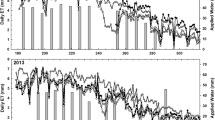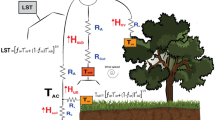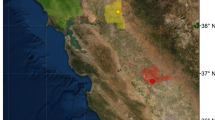Abstract
Surface renewal (SR) is a biometeorological technique that uses high frequency air temperature measurements above a crop surface to estimate sensible heat flux (H). The H derived from SR is then combined with net radiation (Rn) and ground heat flux (G) measurements to estimate latent heat flux (LE) as the residual of an energy balance equation. Recent advances in SR theory enabled its use beyond research settings, and led to the development of an inexpensive, stand-alone SR system for use in commercial agricultural settings. However, these commercial applications require replacing expensive net radiometers with clear sky models designed to estimate Rn for the energy balance approach, while also assuming G is zero on a daily basis. The accuracy of substituting Rn measurements with modelled values is unknown, and the assumption of an inconsequential G requires additional testing. Here, we compare the accuracy of the SR derived estimates of H and LE when Rn is either measured directly or modelled, and we compare results to two eddy covariance (EC) LE observations, namely LE measured via EC with an infrared gas analyzer (ECIRGA) and LE solved as a residual in the surface energy balance (ECresid). These measurements were collected at the Grape Remote sensing Atmospheric Profile & Evapotranspiration eXperiment (GRAPEX) conducted over a vineyard within the Lodi, CA wine growing region. LE from SR using tower Rn data measured directly onsite was significantly correlated with LE from ECresid and from ECIRGA with a least squares regression slope ~ 1. LE derived with the modelled incoming solar radiation (SWi) and DisALEXI Rn approaches were also significantly correlated with LE from ECresid, but both modelling approaches overestimated LE at higher fluxes. Patterns were similar, but with more scatter for correlations between LE from ECIRGA and LE from SR using either modelled or remotely sensed Rn. Incorporating direct measurements of G had minimal impact on the agreement of several SR approaches and LE from both EC approaches, however, when differences did occur direct measures of G reduced scatter and bias especially for the empirical SR approach. Our results suggest that LE derived from the new SR method requires fairly accurate Rn modelling approaches to obtain reliable and unbiased estimates of daily LE in comparison to measured LE using EC techniques.







Similar content being viewed by others
References
Blonquist JM, Allen RG, Bugbee B (2010) An evaluation of the net radiation sub-model in the ASCE standardized reference evapotranspiration equation: implications for evapotranspiration prediction. Agric Water Manag 97:1026–1038
Cammalleri C, Anderson MC, Gao F, Hain CR, Kustas WP (2014) Mapping daily evapotranspiration at field scales over rainfed and irrigated agricultural areas using remote sensing data fusion. Agric For Meteorol 186:1–11
Gao W, Shaw RH, Paw U KT (1989) Observations of organized structure in turbulent flow within and above a forest canopy. Boundary-Layer Meteorol 47:349–377
McElrone AJ, Shapland TM, Calderon A, Paw U KT, Snyder RL (2013) Surface renewal: an advanced micrometeorological method for measuring and processing field-scale energy flux density data. J Vis Exp. https://doi.org/10.3791/50666
Nouvellon Y, Rambal S, Lo Seen D, Moran MS, Lhomme JP, Bégué A, Chehbouni A, Kerr Y (2000) Modeling of daily fluxes of water and carbon from shortgrass steppes. Agric For Meterol. https://doi.org/10.1016/S0168-1923(99)00140-9
Parry CK, Nieto H, Guillevic P, Agam N, Kustas WP, Alfieri JG, McKee LG, McElrone AJ (2019) An intercomparison of radiation partitioning models in vineyard row structured canopies. Irrigation Sci. https://doi.org/10.1007/s00271-019-00621-x
Parry CK, Shapland TM, Williams LE, Calderon-Orellana A, Snyder RL, Paw U KT, McElrone AJ. Comparison of a stand-alone surface renewal method to weighing lysimetry and eddy covariance for determining vineyard evapotranspiration and vine water stress. Irrigation Sci (in review)
Paw U KT, Brunet Y (1991) A surface renewal measure of sensible heat flux density. In: 20th conference on agricultural and forest meteorology, pp. 52–53
Paw U KT, Qiu J, Su HB, Watanabe T, Brunet Y (1995) Surface renewal analysis: a new method to obtain scalar fluxes without velocity data. Agric For Meteorol 74:119–137
Shapland TM, Snyder RL, Smart DR, Williams LE (2012a) Estimation of actual evapotranspiration in winegrape vineyards located on hillside terrain using surface renewalanalysis. Irrig Sci 30:471–484
Shapland TM, McElrone AJ, Snyder RL, Paw U KT (2012b) Structure function analysis of two-scale scalar ramps. Part I: theory and modelling. Bound Layer Meteorol 145:5–25
Shapland TM, McElrone AJ, Snyder RL, Paw U KT (2012c) Structure function analysis of two-scale scalar ramps. Part II: ramp characteristics and surface renewal flux estimation. Bound Layer Meteorol 145:27–44
Shapland TM, McElrone AJ, Paw U KT, Snyder RL (2013) A turnkey data logger program for field-scale energy flux density measurements using eddy covariance and surface renewal. Ital J Agrometeorol 1:1–9
Shapland TM, Snyder RL, Paw U KT, McElrone AJ (2014) Thermocouple frequency response compensation leads to convergence of the surface renewal alpha calibration. Agric For Meteorol 189:36–47
Snyder RL, Spano D, Paw U KT (1996) Surface renewal analysis for sensible and latent heat flux density. Bound Layer Meteorol 77:249–266
Spano D, Snyder RL, Duce P, Paw U KT (1997) Surface renewal analysis for sensible heat flux density using structure functions. Agric For Meteorol 86:259–271
Spano D, Snyder RL, Duce P, Paw U KT (2000) Estimating sensible and latent heat flux densities from grapevine canopies using surface renewal. Agric For Meteorol 104:171–183
Stoy PC, Mauder M, Foken T, Marcolla B, Boegh E, Ibrom A, Arain MA, Arneth A, Aurelai M, Bernhofer C, Cescatti A, Dellwik E, Duce P, Gianelle D, van Gorsel E, Kiely G, Knohl A, Margolis H, McCaughey H, Merbold L, Montagnanit L, Papale D, Reichstein M, Saunders M, Serrano-Ortiz P, Sottocornola M, Spano D, Vaccari F, Varlagin A (2013) A data-driven analysis of energy balance closure across FLUXNET research sites: the role of landscape scale heterogeneity. Agric For Meteorol 171–172:137–152
Van Atta CW (1977) Effect of coherent structures on structure functions of temperature in the atmospheric boundary layer. Arch Mech 29:161–171
Acknowledgements
Funding
provided by E.&J. Gallo Winery contributed towards the acquisition and processing of the ground truth data collected during GRAPEX IOPs. In addition, we would like to thank the staff of Viticulture, Chemistry and Enology Division of E.&J. Gallo Winery for the assistance in the collection and processing of field data during GRAPEX IOPs. Finally, this project would not have been possible without the cooperation of Mr. Ernie Dosio of Pacific Agri Lands Management, along with the Borden vineyard staff, for logistical support of GRAPEX field and research activities. USDA is an equal opportunity provider and employer. The use of trade, firm, or corporation names in this article is for the information and convenience of the reader. Such use does not constitute official endorsement or approval by the US Department of Agriculture or the Agricultural Research Service of any product or service to the exclusion of others that may be suitable.
Author information
Authors and Affiliations
Corresponding author
Additional information
Communicated by J. L. Chávez.
Publisher’s Note
Springer Nature remains neutral with regard to jurisdictional claims in published maps and institutional affiliations.
Rights and permissions
About this article
Cite this article
Parry, C.K., Kustas, W.P., Knipper, K.R. et al. Comparison of vineyard evapotranspiration estimates from surface renewal using measured and modelled energy balance components in the GRAPEX project. Irrig Sci 37, 333–343 (2019). https://doi.org/10.1007/s00271-018-00618-y
Received:
Accepted:
Published:
Issue Date:
DOI: https://doi.org/10.1007/s00271-018-00618-y




